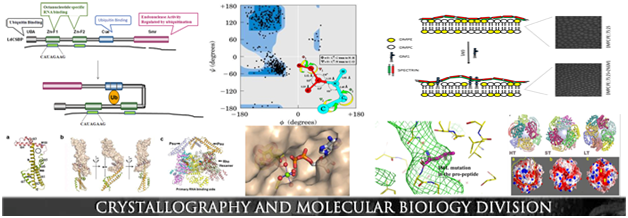
Studies relating the structure and dynamics of biological macromolecules to function are essential part of modern biophysics in order to unravel the mechanism of action of proteins at the molecular level. Using our well-established expertise of recombinant DNA technology, X-ray crystallography and structure-guided protein engineering, we will attempt to understand the mechanism of proteolytic activity of cysteine proteases, alter the function of cysteine proteases, design and generate specific protein inhibitors from serpin family against falcipain2 from Plasmodium falciparum, a drug target for the malaria parasite.Structural and functional aspects of Vibrio cholera proteins involved in many processes such as c-di-GMP mediated biofilm formation, transcription termination and activation (Rho-specific), small heat shock proteins (HSP31, HSP15, DnaK etc.) mediated protein folding and protein phosphorylation/dephosphorylation involved in metabolic activity and signal transduction will be studied in great detail.
During the XII plan period, we have successfully installed and standardized Next Generation Sequencer (NGS). We will elucidate in detail any differential functional involvement of DNA repair protein (Ku) with the replication origin-uses in a spatio-temporal manner during cell cycle using NGS. Post-transcriptional regulation of gene expression during eukaryotic cell cycle progression will also be studied.Several unique sugar metabolizing proteins have been identified in Leishmaniadonavani, which is a protozoan parasite and causes Leishmaniases, and are potential drug targets. These proteins (UDP-Glc 4 ′-epimerase, UDP-galactopyranose mutase, Galactose Mutarotase etc.) will be targeted for structure determination. Further, structural and thermodynamic insights related to the interaction of cyclophilin, a peptidyl-prolyl cis-trans isomerase, with a transmembrane protein CD147 will be examined since this interaction has been implicated in inflammation, cancer and cardiac disorders.
Clones of erythroid spectrin domains e.g. the ankyrin binding domain, self-associating domain, SH3 domain and ‘spectrin repeat’ domains obtained, proteins expressed and purified to explore their protein-protein interactions, chaperone activity and membrane binding potential. New research area on characterizing the structural dynamics of membrane proteins has been initiated while ~30% of human genome codes for membrane proteins and ~60% of available drugs target membrane proteins. In spite of recent successes, structural determination of membrane proteins at atomic level is quite challenging due to poor expression, low purification yields and the low success rate of forming well-ordered 3D crystals. In this context, site-directed spin labeling (SDSL) and Electron Paramagnetic Resonance (EPR) spectroscopy is a powerful technique to provide structural and dynamic information on protein function. Importantly, low-resolution models of proteins in different functional states can be obtained which are not amenable to crystallographic approaches. Regarding the structural dynamics of membrane proteins, research will be focused on understanding the activation gating mechanisms of potassium and magnesium ion channels, and lipid-dependent voltage gating mechanisms.
